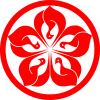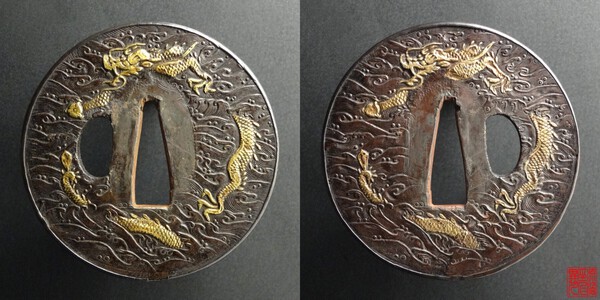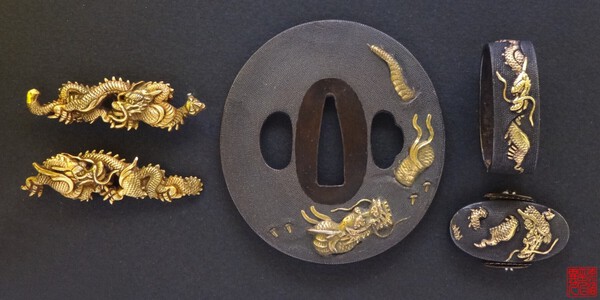-
Posts
474 -
Joined
-
Last visited
-
Days Won
5
Everything posted by zanilu
-
Yes You are right Piers. The second one say Heianjo zogan my mistake! For that one my assumption is that this is due to the lack of the mon that have probalby fallen off. But this only adds to my confusion! Comparing the first one with the others I see no particular differences that can justify the attribution! I have added only a few of those I found! Regards Luca
-
That's exactly my point Dale. We have a lot of attribution from NBTHK of these kind of pieces, all mumei, to Yoshiro and then this one attributed to Heianjo! Attached are the papers for a few of them from my database. The question is why this piece have a different attribution? Regards Luca
-
Dear All I have seen this tsuba for sale on Yahoo Japan. To me it looks clearly as a Kaga Yoshiro piece but it comes with an NBTHK paper to Heianjo Zogan! What am I missing? Do you see any particular reason for the attribution? Regards Luca
-
The largest in my collection: Edo period Katsushi 105.0 mm x 100.0 mm , thickness at seppa dai 2.5 mm, at mimi 3.3 mm. Edo period (Early?) Heianjo Zogan 102.5 mm x 102.3 mm, thickness at seppa dai 4.2 mm, at mimi 4.0 mm. Regards Luca
-
Thank you!
-
Thank you Steve! So it should read koberi kin? Gold border? Regards Luca
-
Dear All I am translating the NBTHK paper of a Nagamine Fuchi/Kashira of recent acquisition. But this bit is puzzling me: It looks like 小縁金 that should sound like ko fuchigane or somehthing like small gold collar. Which is the exact translation and meaning? It is referring to the small gold border on the rim of the fuchi: Thank you in advance for the help Regards Luca
-
Luca, stai parlando male di Garibaldi! (it's an Italian idiomatic expression to say that some opinions cannot be challenged even if overtly misleading) I know Mauro. But this case "Chiede vendetta" (calls for vengeance)! Regards Luca
-
David I agree that it should not be an achademic paper but the criteria used should be given at least... Regards Luca
-
I am lost! I have collected many Yoshiro pieces example here: I have always found frustrating the fact that NBTHK does not provide justification, reasons and references the leader to an attribution. To me the shinsa process is rather opaque! Regards Luca
-
It looks like the essence of Kaga Yoshiro. A manual piece! But what do I know... Regards Luca
-
Dale I suspect that i other side is made by the copper plate you mention in your original post and that the wire mesh is sandwiched between the original tsuba and the copper plate. In the past I have seen passing tsuba with a copper plate added to one side. At the moment I can not find any though. Regards Luca
-
That it is strange is a fact! Shingen? Regards Luca
-
Superbe Steve! I am very grateful! Thank you Best regards Luca
-
Hello everybody I am compiling a review of all the information about Ayanokoji Nagamine that I have gathered so far as I have done in the past for other topics. At the moment I am in need of some help managing the translations of some entry from Wakayama Toso Kodogu Meiji Taikei, since I can not go beyond google translator. Following are the scan from the book and what I got so far: [02] 花洛住 氷筆 (花押) 最近になり 外国資料に [花洛住渡辺即三良行 年六十ー歳 永峯 (花押)] と切つた小 策があるとを確認レた Karaku-ju Nagamine (ka\=o) Saikin ni nari Gaikoku shiryō ni hana raku jū Watanabe soku san Yoshiyuki Toshi roku jū ̄ toshi Nagamine (kaō) to setsu Tsuta-shō Saku ga aru to o kakunin reta Karaku-ju Nagamine (ka\=o) Recently become For foreign materials Hanatsubaki Sayayuki Watanabe 60 years old Nagamine (ka\=o) And small I confirmed that there was a solution Here I think is reported the information about a mei in which the age of 60 for Nagamine is citen. Also cited in Haynes "The Index of Japanese Sword Fittings and Associated Artists" but I have never seen any picture of it. If by chance any of you have it and can share it I will be grateful. [03] 花洛住 氷筆 (花押) 花の字をと異体に切つ たリ この緑銘のように華をくずしたようにみえろ字体に切る Karaku-ju Nagamine (ka\=o) Hana no ji o to itai ni setsutsuta Ri kono midori mei no yō ni hana o kuzushita yō ni mi ero jitai ni kiru Karaku-ju Nagamine (ka\=o) Cut the character of the flower into a different shape. Is it saying something about how a character is cut? [04] 氷筆 (花押) 峰は必ずと切つていろ Nagamine (ka\=o) Mine wa kanarazu to setsu tsute iro Nagamine (ka\=o) Always cut the peak Also here is it saying something about how a character is cut? [05] 氷筆 (花押) この工人の花押を比較すると小異があ リ さらに別形もみられるので 同名二人説や複数説 もある この縁銘内字は他のものとくらべ変わつ ている Nagamine (ka\=o) kono kō hito no kaō o hikaku suruto shōi ga a Ri sarani betsu katachi mo mi rarerunode dōmei futari-setsu ya fukusū-setsu mo aru kono en mei-nai ji wa hoka no mono to kurabe hen watsute iru Nagamine (ka\=o) When comparing this engineer's Hanashoshi, there are minor differences. There are also other forms, so there are two-person theories and multiple theories This inscription is different from the others [06] 氷筆 (花押) 二字銘に花押を添えろのが普通であろ Nagamine (ka\=o) Ni Jimei kaō o soero no ga futsūdearo It's normal to add kao to the two-letter name I know it is a lot to translate anyway I thank you in advance for any help you can offer. Best Regards Luca
-
Thank you Piers for the update!
-
Thank you guys! Always to the point with precise explanations! Again thank you. I have the Sesko encyclopaedia in paper for but I have no access to it right now... . Regards Luca
-
Hello to everybody I am struggling the tranlation of a piece of description in a NBHTK paper of a Higo tsuba. The piece is the following: So far I am stuck with: 焼手 Yakite 腐らし Kusarashi Exposure It should be related to a sort of etching process of the karakusa decoration on the brass surface of the tsuba. Any help on the right pronunciation and traslation of the term is welcome. Best Regards Luca
-
-
Thak you Jussi for your answer! As in most of the cases with Japanese things not a simple straightforward solution to the problem 😅! Regards Luca
-
Hello to all of you I have recently acquired a set composed of a tsuba, fuchi, kashira and menuki, all with the same theme. I was wondering how was the best way to refer to it. I know that futakoromono refers to a set of two items, mitokoromono to a set of three. But for four? Youtsukoromono? Any help is appreciated, more so if you can also provide the kanji for it... Best regards Luca
-
-
After seeing on Ford videos how he handles a chisel I think that the lines are made by chiseling. Just my two cents. Luca
-
No result here either. I have subscribed to their newsletter. I received a confirmation email and then nothing. I ended up here (https://www.metmuseu...nd-armor/newsletters) but I have no clues on how to get the latest newsletter with Markus article.




























